Mahabalipuram—an ancient coastal town where history is etched in stone and mythology comes alive. During my recent South India tour, I had the opportunity to explore this UNESCO World Heritage site, which showcases some of the finest examples of Pallava art and architecture dating back to the 7th-8th centuries.
Journey to Mahabalipuram from Chennai
Our journey began in Chennai, with a comfortable drive along the picturesque East Coast Road (ECR). This coastal highway offers stunning views of the Bay of Bengal on one side and lush greenery on the other. The approximately 60 km journey took us around 1.5 hours, but we decided to make the most of it with a brief stop along the way.
As the modern cityscape of Chennai gradually gave way to fishing villages and salt pans, we could feel the transition from urban chaos to coastal tranquility. The drive itself was a refreshing experience, with the sea breeze providing relief from the typical South Indian heat.
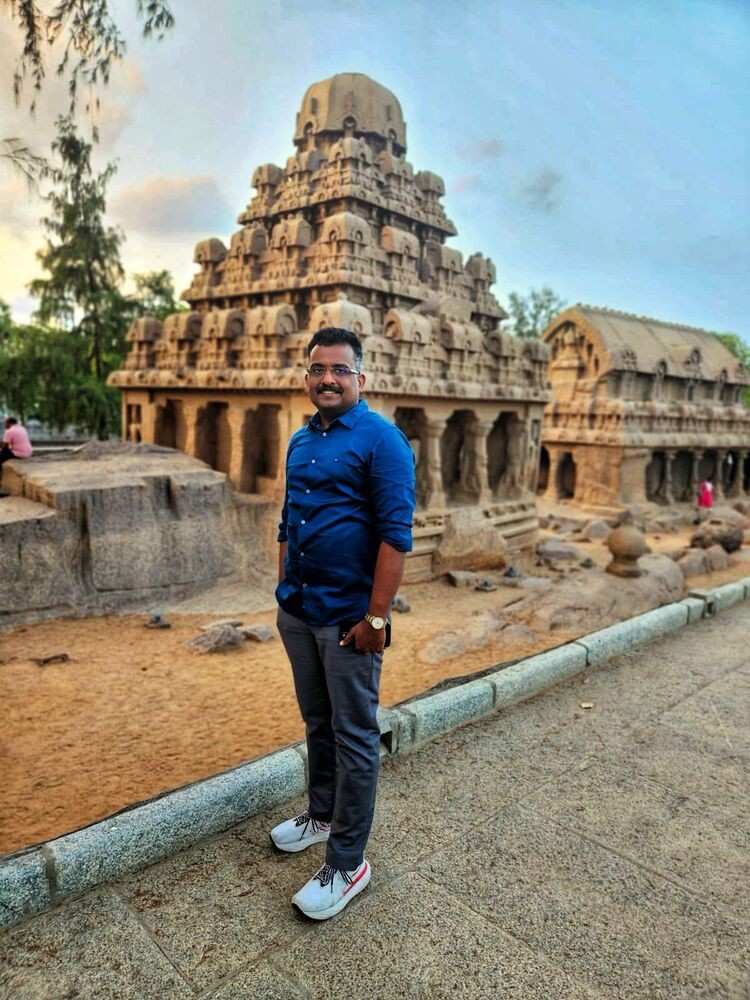
A Stopover at Muttukadu Backwaters
About 36 km from Chennai, we made our first stop at the serene Muttukadu Backwaters. This tranquil spot offers a perfect break in the journey and a chance to experience the coastal ecosystem of Tamil Nadu up close.
We opted for a speed boat ride (₹400 for two people) that lasted about 15 minutes. The experience of gliding over the calm waters, surrounded by mangroves and occasional fishing boats, was both relaxing and exhilarating. For those with more time, pedal boats and longer cruises are also available, especially recommended during sunset hours.

Arriving in Mahabalipuram: A Town Frozen in Time
By early afternoon, we reached Mahabalipuram, also known as Mamallapuram. The town's very name evokes its rich history—it was named after the Pallava king Narasimhavarman I, who was known as 'Mamalla' (the great wrestler). As a major seaport during the Pallava dynasty, it facilitated trade with Southeast Asian countries, evident in some Chinese influences in its art.
What makes Mahabalipuram truly special is how the entire town feels like an open-air museum. Unlike many heritage sites that are confined to specific areas, here the monuments are scattered throughout the town, allowing visitors to literally walk through history.
The Five Rathas: Monolithic Marvel
Our exploration began with the Pancha Rathas (Five Rathas), one of the most remarkable examples of monolithic architecture in India. Each of these chariot-shaped temples is carved from a single piece of granite, showcasing the extraordinary skill of ancient craftsmen.
Named after the Pandavas and Draupadi from the Mahabharata, these structures were never actually completed or consecrated as temples. What's fascinating is that each ratha has a distinct architectural style, suggesting that this site may have been an architectural laboratory of sorts for the Pallava artisans.
The detailed carvings on the exteriors depict various deities, mythological scenes, and everyday life in the Pallava era. The life-sized elephant sculpture near the Rathas adds to the charm of this complex.
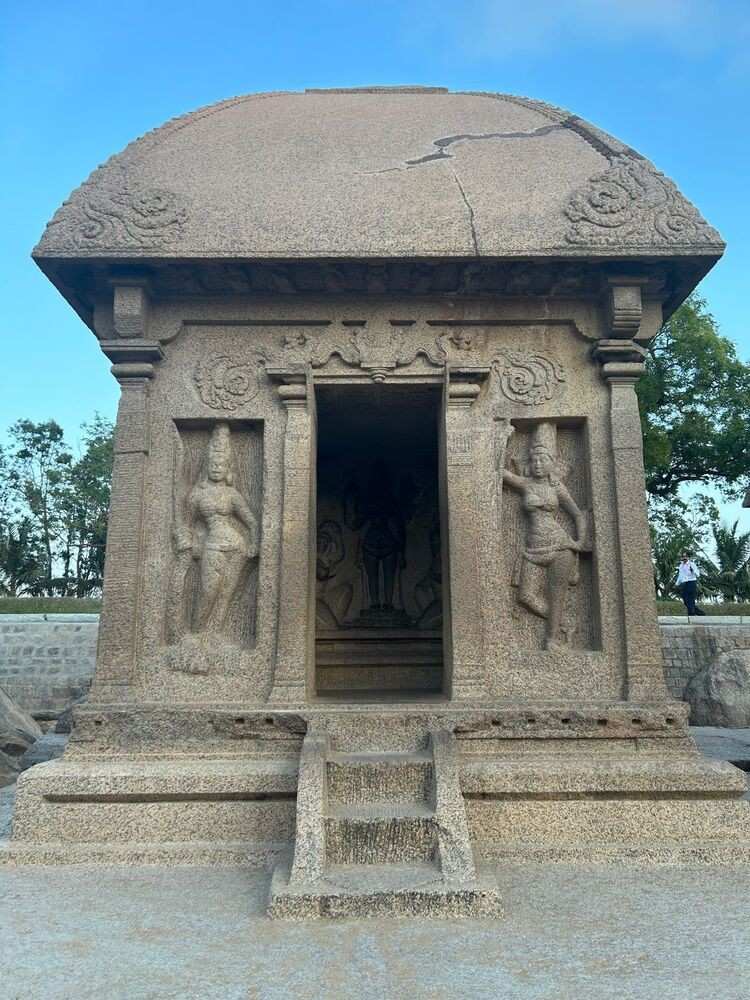
Arjuna's Penance: A Stone Canvas
A short walk from the Rathas brought us to one of the most impressive rock reliefs in the world—Arjuna's Penance, also known as the Descent of the Ganges. This massive open-air rock carving stretches 96 feet in length and stands 43 feet high, making it one of the largest rock reliefs in Asia.
The central cleft in the rock is believed to represent the River Ganges, with countless figures carved on either side—gods, goddesses, celestial beings, animals, and humans, all portrayed in exquisite detail. Our guide pointed out fascinating details that we might have missed otherwise, like the natural shelter where a family of deer is depicted, and the mischievous monkeys mimicking human postures.
The carving tells two possible stories: either Arjuna's penance to obtain Lord Shiva's weapon, or Bhagiratha's penance to bring the Ganges down to Earth. The ambiguity adds to its mystique, allowing visitors to interpret the masterpiece through different mythological lenses.
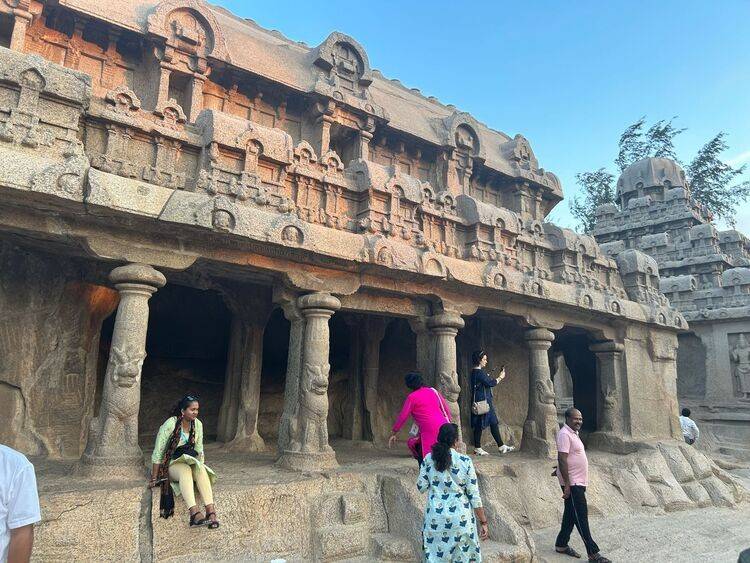
Krishna's Butter Ball: Defying Gravity
Perhaps the most whimsical attraction in Mahabalipuram is Krishna's Butter Ball—a giant granite boulder approximately 6 meters high and 5 meters wide, perched precariously on a smooth slope. What makes it extraordinary is that despite its seemingly unstable position, it has remained unmoved for centuries, surviving even natural disasters like the 2004 tsunami.
Named after the Hindu god Krishna's fondness for butter, this natural wonder has become a favorite spot for tourists to take creative photographs. We couldn't resist joining the queue of visitors posing as if pushing or supporting the massive rock. The surrounding area, with its green lawns and ancient rock formations, provides a perfect setting for a short break from the intense historical exploration.

Cave Temples: Stories Carved in Stone
Mahabalipuram is home to several magnificent cave temples, each with its own unique charm and mythological narratives. The Varaha Cave Temple, dedicated to Vishnu's boar avatar, features some of the most delicate and well-preserved reliefs in the complex, including the famous panel of Vishnu rescuing Earth.
The Mahishasuramardhini Cave depicts the goddess Durga battling the buffalo demon on one panel, while another shows Vishnu in his cosmic sleep. What struck me most about these caves was the three-dimensional quality of the sculptures—they seem to emerge from the rock rather than being carved into it, creating a remarkable sense of depth and movement.
The way natural light plays within these caves throughout the day highlights different aspects of the carvings, making them appear almost animated. Our guide suggested visiting the caves during different times of the day for varied experiences.
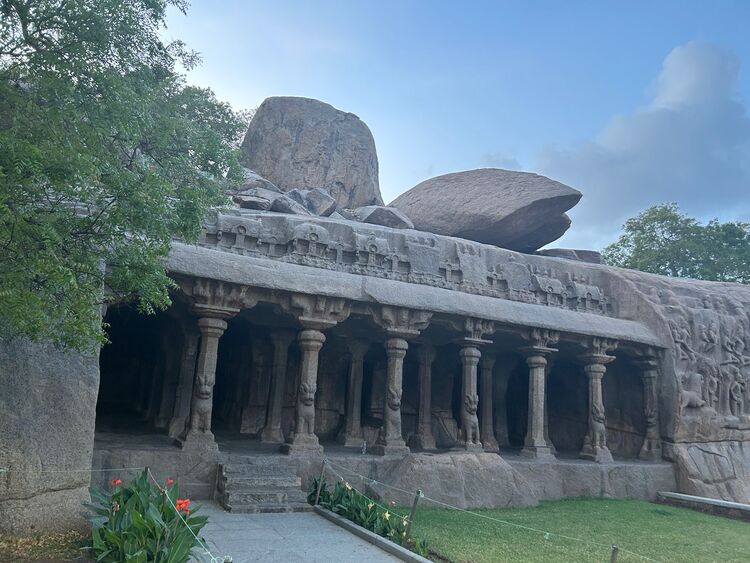
The Shore Temple: Standing Against Time and Tide
As the day progressed, we saved the most iconic structure for late afternoon—the Shore Temple. Built around 700-728 CE during the reign of Narasimhavarman II, this granite temple stands majestically on the shores of the Bay of Bengal, having withstood the salt spray and coastal storms for over 1,300 years.
Unlike the other monuments in Mahabalipuram that were carved from existing rock formations, the Shore Temple was built using cut stones. Its pyramidal structure houses shrines dedicated to both Shiva and Vishnu, reflecting the religious inclusivity of the Pallava period.
What makes the Shore Temple particularly fascinating is that it's believed to be just one of seven temples that once lined the coast—the others now submerged under the sea. After the 2004 tsunami, receding waters temporarily revealed some submerged structures, confirming ancient local legends about the "Seven Pagodas of Mahabalipuram."
The lawns surrounding the temple are well-maintained and provide a perfect vantage point to appreciate both the architectural marvel and the endless expanse of the Bay of Bengal beyond. Watching the waves crash against the rocks below while the ancient temple stands unperturbed creates a powerful image of resilience across centuries.
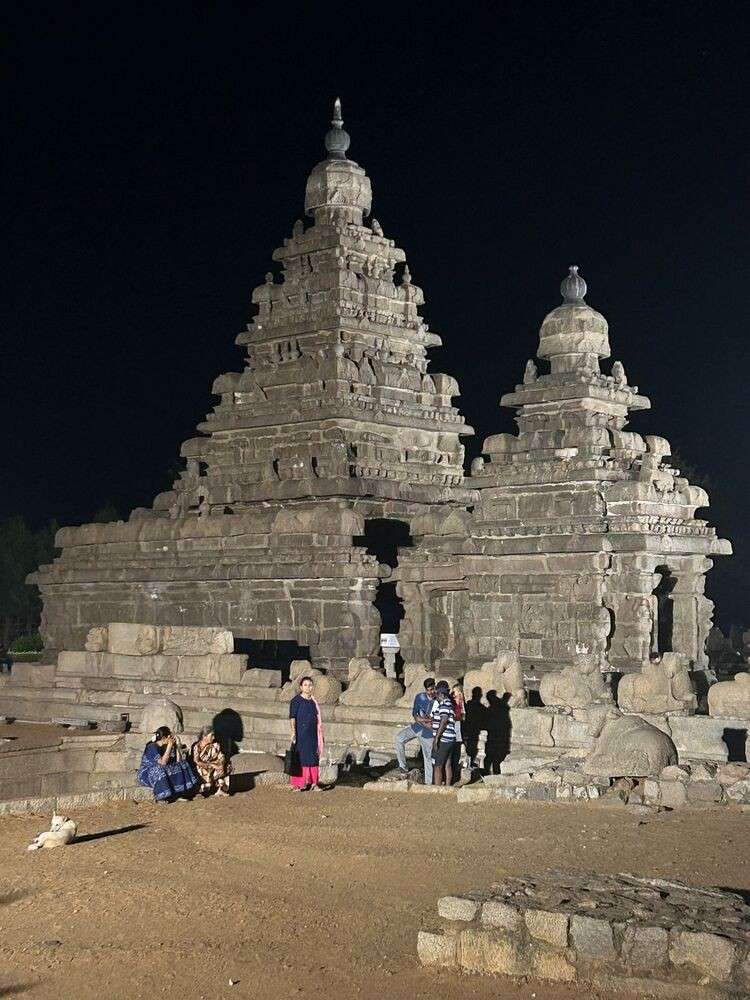
Mahabalipuram Beach: Sunset by the Sea
After a day filled with historical exploration, we ended our visit with a relaxing stroll along Mahabalipuram Beach. Unlike the more commercialized beaches, this stretch has a rustic charm with local fishing boats dotting the shoreline and food stalls offering fresh seafood.
The beach area next to the Shore Temple offers spectacular sunset views, with the silhouette of the temple against the orange sky creating postcard-perfect moments. The cool evening breeze and the rhythmic sound of waves provided a calming conclusion to our heritage-intensive day.
Stone Carving Workshops: Living Tradition
Before leaving Mahabalipuram, we visited one of the many stone carving workshops that line the main road. What's remarkable about this town is that the ancient art of stone carving continues to thrive as a living tradition, passed down through generations.
We watched skilled artisans transform rough granite blocks into intricate sculptures using techniques not vastly different from those employed by their ancestors over a millennium ago. These workshops offer everything from massive garden sculptures to delicate miniatures and jewelry, making them perfect places to pick up authentic souvenirs.
I purchased a small Nandi bull sculpture, impressed by the detail achieved in such a compact piece. The artisan explained that each piece takes days to complete, with the final polishing process being particularly time-consuming to achieve the characteristic smooth finish.
Local Cuisine: Seafood Delights
Being a coastal town, Mahabalipuram offers excellent seafood options. For lunch, we dined at a local seaside restaurant where we enjoyed freshly caught fish prepared in traditional Tamil style. Here are some must-try dishes when visiting:
- Meen Kuzhambu – A tangy fish curry with tamarind
- Nandu Masala – Spicy crab preparation
- Eral Varuval – Spicy prawn fry
- Chettinad Fish Fry – Fish marinated in spices and fried to perfection
- Fresh Coconut Water – Perfect refreshment for the coastal heat
Practical Information for Visitors
For those planning to visit Mahabalipuram, here are some useful details:
- Entry Fees: ₹40 for Indians, ₹600 for foreigners (covers most monuments)
- Best Visiting Hours: Early morning (6-9 AM) or late afternoon (3-6 PM) to avoid the midday heat
- Time Required: Minimum of 4-6 hours for a comprehensive visit
- Guides: Available at the entrance for approximately ₹600-800, well worth the investment
- What to Wear: Comfortable footwear for walking on uneven terrain, modest clothing for temple visits
- What to Bring: Sunscreen, hat, water bottle, camera
Extending Your Trip: Making Mahabalipuram Part of a Larger Itinerary
Mahabalipuram fits perfectly into a wider South India cultural circuit. For those with more time, consider this extended itinerary:
- Chennai → Mahabalipuram (1-2 days)
- Pondicherry (2 days) – French colonial charm just 100 km south
- Thanjavur & Trichy (2-3 days) – To explore the magnificent Brihadeeswarar Temple and Rock Fort
- Madurai (2 days) – Home to the spectacular Meenakshi Amman Temple
- Kanyakumari (1 day) – The southernmost tip of mainland India
- Kerala (5-7 days) – For backwaters, hill stations, and beaches
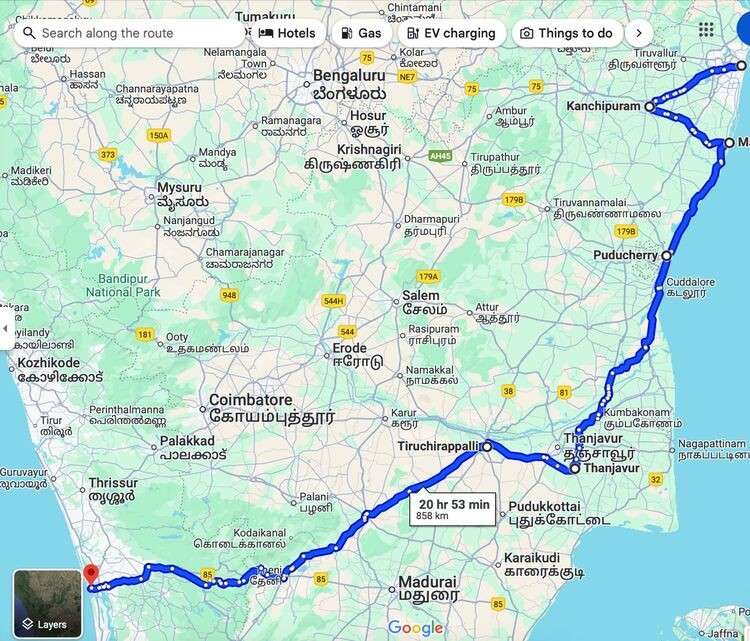
Conclusion: A Timeless Heritage Experience
My visit to Mahabalipuram was more than just a sightseeing tour—it was a journey through centuries of artistic and cultural evolution. The way these ancient artisans transformed rugged granite into flowing narratives and intricate sculptures speaks to the creative genius of early Indian civilization.
Whether you're a history enthusiast, photography lover, or spiritual seeker, Mahabalipuram offers a profound connection with India's rich heritage. The town's UNESCO World Heritage status is well-deserved, protecting these treasures for future generations to appreciate and learn from.
As I left this coastal town of stone wonders, I carried with me not just photographs and souvenirs, but a deeper appreciation for the artistic legacy of the Pallavas and the enduring power of human creativity. Mahabalipuram isn't just a checkbox on a travel itinerary—it's an experience that stays with you long after you've moved on to your next destination.